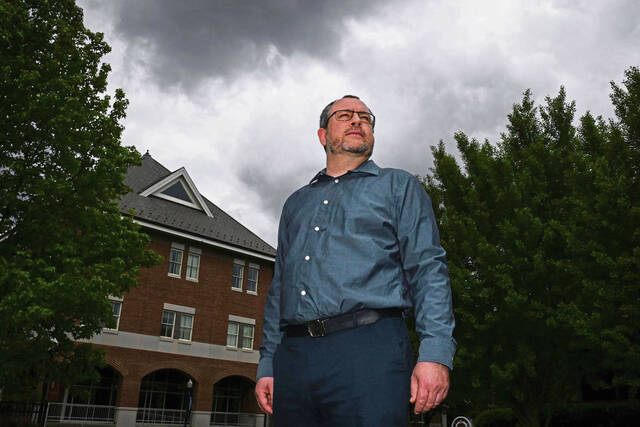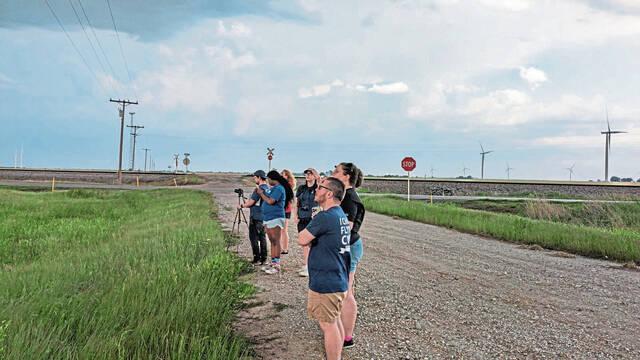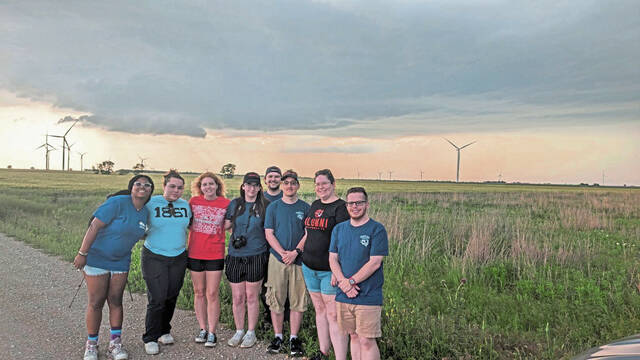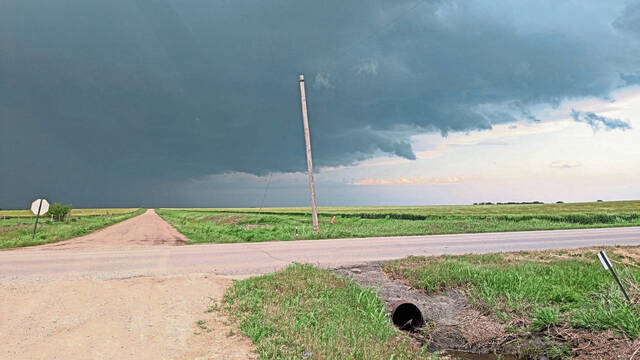PennWest students on whirlwind storm-chasing trip
PennWest California student Jared Riley says he’s an adrenaline junkie who keeps a close eye on the weather.
When he clambered out of the van he was sharing with classmates last week and saw a supercell thunderstorm up close, his excitement was palpable.
Once he and his group drove close enough to see the mesocyclone — a rotating portion of a storm cell that can precede tornadoes — they could feel the downdraft wind whipping around them and their vehicle. One student’s glasses went flying off into a ditch.
“It’s just fun being out there,” Riley said. “Once we’re in storm mode, that adrenaline kicks in, and we focus on what we’re doing.”
Riley is part of a team of eight PennWest students, along with professor of atmospheric sciences Mario Majcen, 48, who went on a storm-chasing journey across the Midwest.
While 5 tornadoes were confirmed in western Pennsylvania and Ohio after their departure, the students and Majcen were out in the field, driving in two rented Chrysler Pacifica minivans, seeking severe thunderstorms and tornadoes to study.
“We are happy to hear that there were no fatalities (to the best of my knowledge) in our home region associated with these tornadoes,” Majcen said of the storms that touched down in the region.
“Tornadoes are hard to visually observe safely in Pittsburgh region due to topography so we are glad that nobody got hurt and that people heeded the National Weather Service warnings,” he said.
The annual program gives students interested in meteorology and environmental science hands-on experience with forecasting storms. Originally associated with California University of Pennsylvania’s meteorology concentration, it is now run through the sustainability and climate science program, following the merger that created PennWest.
The trip has been running out of the Cal U campus since 2000 and was founded by adjunct faculty Wayne Verno, who now works at The Weather Channel. Majcen has led the trip since 2010.
This is the first year the trip has been open to students from all three of PennWest’s campuses, and students from both California and Clarion are attending this time.
“Students, with my help, forecast for severe weather,” Majcen said. “We basically cover the whole Midwest chasing storms and trying to see tornadoes.”
Clarion campus student Kennedy Brown said she was particularly looking forward to learning from other students in the group and applying what she has studied.
“I think the development (of storms) is really cool, learning about it,” she said. “Being able to chase it and see it up close to understand it on more of an intricate level that isn’t from a textbook would be really neat.”
Weather journey
For 15 days, the students are traveling across a geographical area covering northern Texas, Oklahoma, eastern Colorado, Nebraska, Iowa and parts of southern South Dakota.
Each morning begins with a weather briefing, when the group analyzes data and makes a plan for where they will head next in pursuit of storms.
Storms usually develop in the mid-to-late afternoon, Majcen said, so the early part of the day is often devoted to driving. In the late afternoon and early evening, the group meets for a second weather briefing, where they tentatively plan their course for the next day.
“It’s about 6,000 miles in two weeks, so it’s quite intense — but it’s fun,” Majcen said.
Tornadoes are not common sights. Through 20 trips in the program’s history, only three tornadoes have been spotted by students, Majcen said. But the group is usually able to observe other severe storms.
“Every trip has really, really cool severe weather, like supercell thunderstorms, where you can see the structure of the storms,” Majcen said. “It’s very exciting, but luckily for everybody, tornadoes are quite rare. You have to be at the right place at the right time.”
When the group finds a storm, the goal is to get as close as safely possible so students can observe its structure. They may take observations of local temperatures, winds and humidity, using laptops and tablets in the vans to note weather data.
If the weather is sunny and no storms are within range, the group will visit local attractions, national parks or historical sites. On this trip, the team also got to check out the National Weather Center in Norman, Okla.
“It’s always educational for students — it’s always something new and something else to do,” Majcen said, noting that the trip also is an opportunity to introduce students to an area they may not have previously visited. “Spending two weeks on the Great Plains is amazing. And for me as an instructor, I see the changes in their perspective and how they really like that aspect of the trip.”
Learning on the road
Students on the trip hail from Brownsville, Buffalo Township, Cochranton, Fredericktown, Pittsburgh, West Deer and Bunker Hill, W.Va.
Justina Arena, a graduate student who participated in last year’s trip, said the program is eye-opening. Her interest in severe weather was sparked by Hurricane Andrew and inspired by her daughter’s childhood interest in becoming an astronaut — she wanted to be able to forecast the weather if her daughter ever went to space.
“Unless you can actually see it in real life, you really can’t grasp everything,” she said. “It was so cool to be able to go out and look at rotation and clouds, and check the radar, try to find the spots where hopefully we can see a tornado.”
For the group — many of whom are what she jokingly referred to as “weather weenies” — being in the field is exciting.
“That adrenaline just hits strong. You just want to go and look,” she said. “You do have a little bit of anxiety — I think everybody experiences some storm anxiety when you’re out chasing — but the adrenaline takes over pretty fast.”
The students are careful, she emphasized. Whenever the team approaches a potentially dangerous storm, members plan “escape routes,” or paths that the van could take to exit the situation.
“On the previous trips, what we did was we had opportunities to get closer to a storm to potentially see a tornado, but we did not do that because we deemed the situation to be unsafe,” Majcen said. “We are always working within the safety parameters. If we deem it unsafe, we will not pursue.”
“If you’re not driving or the passenger, all three of us in our vehicle are constantly looking at the radars, velocity scans and keeping an eye on the storm, because the driver and passenger can’t always do that,” Riley added.
Majcen said “storm-chasing” is more of a colloquial term. It can include amateur storm enthusiasts, whom the group sometime sees on the road and tries to avoid.
“We call this trip ‘storm intercept,’ because storm-chasing is kind of a misnomer,” he said. “If you know what you are doing, you want to be in front of the storm. If you are behind, you are too late.”
Studying storms can be dangerous if you don’t know what you’re doing, he said.
“We know the structure of the storms,” he said. “The students are well-prepared and educated, I have a Ph.D. in meteorology. We know the storm environment, where it’s safe to be and where it’s risky to be.”
Seeing the storm
As a geoscience major, Brown was encouraged by the chance to get some hands-on experience. Last Wednesday’s supercell thunderstorm was a treat.
“We saw it slowly rotate, which was really neat,” Brown said. “Seeing it form — and Dr. Mario would slowly explain what we were seeing — we were able to see the updraft happen, and also the downdraft behind it, which was really neat to see that up close.”
“(It’s) not just understanding how it works, but actually getting out there in real time to see how it works, and expanding on our knowledge from the textbooks,” Riley said.
Atmospheric sciences are particularly difficult to study in a lab.
“We take students where the natural phenomena are,” he said. “It’s one of those things that, unless you experience this in person, you just don’t have the full grasp of the totality of that weather phenomenon.”
Brenda Fredette, dean of PennWest’s College of Science, Technology and Business, said trips like this help students “ignite a passion” for their fields and introduce them to new career opportunities.
“Experiences like this, these types of experiences where you can take the theoretical and the concepts that the students are leaning in the classroom and have them go out into the world and experience it, it’s life-changing for students,” she said.
Some students are interested in severe weather from the perspective of damage control and public safety. Others are interested from a climate change perspective, looking into how weather will change in the future. Riley said he was interested in severe weather photography and journalism.
“I really like that different students find different interests in this trip,” Majcen said. “They’re choosing different career paths in the future. This really enables them to.”
Brian Zimmerman, interim associate dean at PennWest’s College of Science, Technology and Business, noted that the focus on safety on field work trips can be useful in a career setting.
“We spend a lot of time in all these field courses talking about field safety. That carries over to when they are employed, because safety is a big concern for any kind of field work you do in your employment,” he said.
The hands-on work tends to stick with students, he said.
“We can do a lot virtually and in the classroom, but I can recall my undergrad field experiences like they were yesterday,” he said. “They really were that impactful.”
Julia Maruca is a TribLive reporter covering health and the Greensburg and Hempfield areas. She joined the Trib in 2022 after working at the Butler Eagle covering southwestern Butler County. She can be reached at jmaruca@triblive.com.
Remove the ads from your TribLIVE reading experience but still support the journalists who create the content with TribLIVE Ad-Free.






